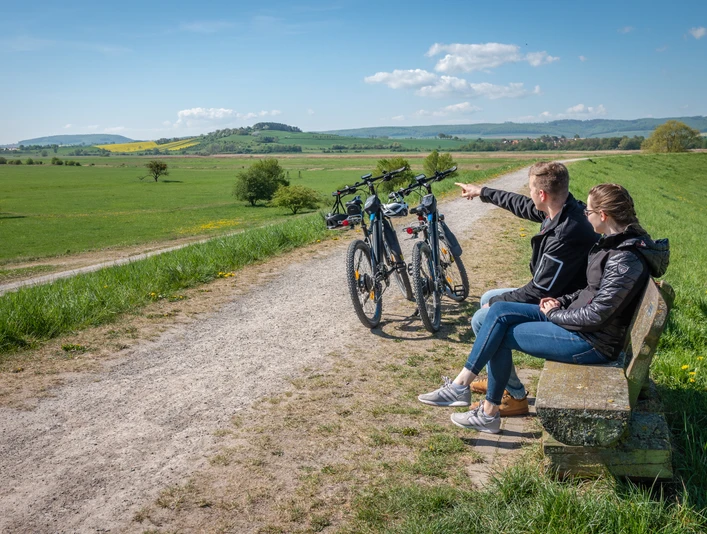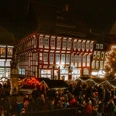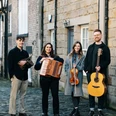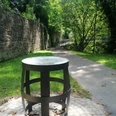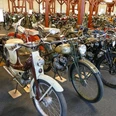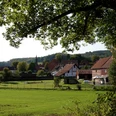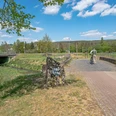For about 25 kilometres, this loop cycling route takes you through the south-eastern part of the city district along culturally interesting sights.
Route logotype are green stylised castle ruins.
At the starting point there is a showcase with an overview of the route.
The cycling route connects two important topics of the location: On the one hand salt and salt extraction, and on the other hand our many castles in different villages.
If you need tips and further information on this tour, click further down onto the tips of the author, starting point and route description!
You would like carry on cycling? Just go ahead and discover our approx. 27 kilometres long cycling route Bridges & Borders.
Route logotype are green stylised castle ruins.
At the starting point there is a showcase with an overview of the route.
The cycling route connects two important topics of the location: On the one hand salt and salt extraction, and on the other hand our many castles in different villages.
If you need tips and further information on this tour, click further down onto the tips of the author, starting point and route description!
You would like carry on cycling? Just go ahead and discover our approx. 27 kilometres long cycling route Bridges & Borders.
Good to know
Pavements
Unknown
Asphalt
Trackless
Best to visit
suitable
Depends on weather
Directions
How to get there: Starting point and destination: See route directions
1. Diek Tower and Historic Water Casing
On the way from Market Square via the streets Benser Straße and Reinserturmweg to the starting point you will pass by Diek Tower. Here, you may visit parts of the old town fortifications. At this location, the purpose of the mighty stronghold with a wall thickness of nearly three metres was to safeguard the water provision of the town. In the wall there is an arch through that the water of the Mill Channel was conducted. This way, it was possible to provide three mills with water at the same time. Directly behind Diek Tower there is an old water viaduct. The Mill Channel that crosses the stream Krummes Wasser at a heights of two metres, is said to have been created at the beginning of the 15th century. Today, it is one of the three emblems of our city.
2. Rotenkirchen
Rotenkirchen is an old grubbing settlement that was first mentioned in 1203 as an estate of Grubenhagen castle that towers over it. For centuries this place was tightly connected with the history and the fate of the castle and its lords. Thus, Rotenkirchen was completely destroyed during a siege of the castle in 1448. It was only in 1520 that the sovereign estate was reconstructed. The palace that is located at the street, the cavalier house and the pleasure garden are originated in that time. In 1811, the estate was converted into a hunting lodge on behalf the vice king of Hannover, the Duke of Cambridge. From 1826 to 1866, Rotenkirchen was the summer residence of the kings of Hannover. Today, the agricultural holding of the Cramm family is located on the estate – with its focus on farming. The site may only be viewed from the outside.
INFO: In front of the estate, in summer 2022 an information point for cyclists will be set up here including a bench and bicycle stands so that it can serve as a starting point for hikes to the Ahlsburg. A showcase will inform on the historic centre of the village, Grubenhagen castle and three hiking routes.
3. Grubenhagen castle ruins
If you would like to leave the route and take a short detour to the castle ruins, from Rotenkirchen follow the main street in direction to Edemissen/Dörrigsen. Approx. 250 metres behind the exit of Rotenkirchen there is a path leading up to the castle ruins (signposted). After a steeper drive of two kilometres you reach the mountain with Grubenhagen castle ruins. However, the last part of the way, the slope onto the castle site located at a heights of 300 metres is too difficult to go by bike.
Hike up to the ruins. If you would like to ask for the tower key at the association Grubenhagen castle (D. Schrader, Mobil: +49 151 / 40 55 84 22, Tel. +49 55 61 / 84 22), you will be able to enjoy a beautiful view in eastern direction from the top. Prior arrangement, the fireplace room in the building annex of the tower may be used.
In the early 13th century the castle belonged to the powerful Count of Dassel. The castellans, the Nobles of Grube, gave the castle its name. At the end of the 13th century it passed to Welf possession. In 1449, it withheld a siege by the Duke of Hessen without greater damage. After the official residence was relocated to Rotenkirchen in the 16th century, the castle started to deteriorate. The restored tower is well preserved. However, today nothing is left of the other buildings of the formerly strongly fortified castle.
Note: Detour of approx. 4.5 km– altitude 150 metres.
4. Mountain range Ahlsburg
The mountain range Ahlsburg is a closed forest area that stands out significantly from its surroundings with 400 a.s.l.. Like a green belt, the elevation accompanies the eastern part of the Leine valley on a length of 12 kilometres. The Ahlsburg with its surroundings is rightly one of the most popular hiking areas in Einbeck’s proximity.
5. Saltworks Sülbeck
The development of Sülbeck starting in 1680 was, unlike the surrounding villages, relevantly influenced by the saltworks. In the rift zone of the Leine valley salt rocks (salines) were formed in the geological period Perm. Already before the saltworks establishment, salt-containing wells with a salt content of up to nine percent could be found close to Sülbeck as well as close to Salzderhelden – these have dried up today. Since 1682, salt is extracted at the saltworks Sülbeck. At the end of the 19th century there were two 400 metres deep drillings made in order to increase the profitability of the saltworks. Until 1909, there was even a harbour from that salt was shipped across the so-called salt ditch to the river Leine. The salt ditch cannot be seen anymore today. Until the mid 50-s of the 20th century salt was produced by evaporation (so-called Sotten). Today, this technical monument may claim to be the oldest preserved saltworks facility in Lower Saxony.
TIP: It is possible to visit the saltworks according to previous arrangement. Contact for guided tours of the facility: Sülbecker Geschichts- und Heimatverein (Sülbeck’s history and home association), Tel. +49 55 61 / 8 10 73 or +49 55 61 / 98 22 70.
6. Flood retention reservoir and Leine polder – a paradise
Human intervention in nature does not always have to have a negative outcome. Because of yearly-occurring flooding of the Leine river, a 1000 hectares large flood retention reservoir was built between Einbeck and Northeim at the beginning of the 70-s. Thus, a nature paradise was created that is home to many animals and plants. Since 2002, the Leine polders are part of the EU bird sanctuary V08 and therefore a valuable habitat for numerous species of flora and fauna.
Directly at the centre of the Leine polder there is the so-called Kiebitzfleck (lawping spot). In a depth of approximately 300 metres there is a salt dome originated in the Perm period from that salt-containing water comes out.
Information: www.naturerlebnis-leinepolder.de
TIPS: Public guided tours of the Leine polder take place during bird migration in spring and in autumn. You may find further guided tours such as e. g. the guided tours on orchids, discovering the polder by bike or a polder safari as well as further information at www.naturscouts-leinetal.de. Guided tours of the Salzderhelden dam according to previous arrangement: Tel. +49 55 61 / 9 90 80.
7. The castle Heldenburg
The castle that was built on the southern toe wall of the steep shell stone mountain range was first mentioned in 1321. At first, it belonged to the Count of Dassel and served as residence for the Welf dukes of the principality Grubenhagen (until 1596). During a siege in 1365, it was the first time that a Bleibüchse (small lead canon) was used on grounds of Lower Saxony – this prevented the castle from being conquered. The castle may be visited. There is an information panel on its history. The multiple storey walling, the great hall, the masonry of the single-nave castle chapel and a square tower stump are still well recognizable. The castle Heldenburg is also said to be the origin of the Saxon Steed, the emblem of Lower Saxony.
TIP: You may gather interesting information on the history of castle Heldenburg on information panels.
8. Salzderhelden with saltworks
According to legend, the brine spring was discovered in the 12th century, but it was first mentioned in a document in 1332. Salt extraction left its mark on around 800 years of history of the larger village Salzderhelden. In 1757, 15 boiling houses of the villages were rebuilt as a unitary saltworks facility Auf dem Flamke and joined to a salt union. Until the 20th century, Salzderhelden and its saltworks was an industrial settlement. Since 1852, the brine was also used in the bathhouse for bathing and inhalation.
After the saltworks were shut down (1963) and bathing was discontinued (1994) all saltworks facilities, apart from drilling rig II, the brine tank and the bathing house were dismantled. In 2009, drilling rig II was restored by means of subsidies and commitment of volunteers and therefore guided tours were made possible again. The old saltworks (Alte Saline) were reopened as an industrial monument in 2011. In summer 2020, a fire destroyed drilling rig II originally built in 1884. The brine tank dated 1882 and the bathing house were spared by the fire.
TIP: Stop at Salzderhelden train station. Located in the station’s building you will find the hands-on kiosk “zur molli”. You can strengthen yourselves with food and beverages indoors or on the terrace for the last part of your cycling tour. If there is a platform concert on that day, you will be able to listen to life music.
1. Diek Tower and Historic Water Casing
On the way from Market Square via the streets Benser Straße and Reinserturmweg to the starting point you will pass by Diek Tower. Here, you may visit parts of the old town fortifications. At this location, the purpose of the mighty stronghold with a wall thickness of nearly three metres was to safeguard the water provision of the town. In the wall there is an arch through that the water of the Mill Channel was conducted. This way, it was possible to provide three mills with water at the same time. Directly behind Diek Tower there is an old water viaduct. The Mill Channel that crosses the stream Krummes Wasser at a heights of two metres, is said to have been created at the beginning of the 15th century. Today, it is one of the three emblems of our city.
2. Rotenkirchen
Rotenkirchen is an old grubbing settlement that was first mentioned in 1203 as an estate of Grubenhagen castle that towers over it. For centuries this place was tightly connected with the history and the fate of the castle and its lords. Thus, Rotenkirchen was completely destroyed during a siege of the castle in 1448. It was only in 1520 that the sovereign estate was reconstructed. The palace that is located at the street, the cavalier house and the pleasure garden are originated in that time. In 1811, the estate was converted into a hunting lodge on behalf the vice king of Hannover, the Duke of Cambridge. From 1826 to 1866, Rotenkirchen was the summer residence of the kings of Hannover. Today, the agricultural holding of the Cramm family is located on the estate – with its focus on farming. The site may only be viewed from the outside.
INFO: In front of the estate, in summer 2022 an information point for cyclists will be set up here including a bench and bicycle stands so that it can serve as a starting point for hikes to the Ahlsburg. A showcase will inform on the historic centre of the village, Grubenhagen castle and three hiking routes.
3. Grubenhagen castle ruins
If you would like to leave the route and take a short detour to the castle ruins, from Rotenkirchen follow the main street in direction to Edemissen/Dörrigsen. Approx. 250 metres behind the exit of Rotenkirchen there is a path leading up to the castle ruins (signposted). After a steeper drive of two kilometres you reach the mountain with Grubenhagen castle ruins. However, the last part of the way, the slope onto the castle site located at a heights of 300 metres is too difficult to go by bike.
Hike up to the ruins. If you would like to ask for the tower key at the association Grubenhagen castle (D. Schrader, Mobil: +49 151 / 40 55 84 22, Tel. +49 55 61 / 84 22), you will be able to enjoy a beautiful view in eastern direction from the top. Prior arrangement, the fireplace room in the building annex of the tower may be used.
In the early 13th century the castle belonged to the powerful Count of Dassel. The castellans, the Nobles of Grube, gave the castle its name. At the end of the 13th century it passed to Welf possession. In 1449, it withheld a siege by the Duke of Hessen without greater damage. After the official residence was relocated to Rotenkirchen in the 16th century, the castle started to deteriorate. The restored tower is well preserved. However, today nothing is left of the other buildings of the formerly strongly fortified castle.
Note: Detour of approx. 4.5 km– altitude 150 metres.
4. Mountain range Ahlsburg
The mountain range Ahlsburg is a closed forest area that stands out significantly from its surroundings with 400 a.s.l.. Like a green belt, the elevation accompanies the eastern part of the Leine valley on a length of 12 kilometres. The Ahlsburg with its surroundings is rightly one of the most popular hiking areas in Einbeck’s proximity.
5. Saltworks Sülbeck
The development of Sülbeck starting in 1680 was, unlike the surrounding villages, relevantly influenced by the saltworks. In the rift zone of the Leine valley salt rocks (salines) were formed in the geological period Perm. Already before the saltworks establishment, salt-containing wells with a salt content of up to nine percent could be found close to Sülbeck as well as close to Salzderhelden – these have dried up today. Since 1682, salt is extracted at the saltworks Sülbeck. At the end of the 19th century there were two 400 metres deep drillings made in order to increase the profitability of the saltworks. Until 1909, there was even a harbour from that salt was shipped across the so-called salt ditch to the river Leine. The salt ditch cannot be seen anymore today. Until the mid 50-s of the 20th century salt was produced by evaporation (so-called Sotten). Today, this technical monument may claim to be the oldest preserved saltworks facility in Lower Saxony.
TIP: It is possible to visit the saltworks according to previous arrangement. Contact for guided tours of the facility: Sülbecker Geschichts- und Heimatverein (Sülbeck’s history and home association), Tel. +49 55 61 / 8 10 73 or +49 55 61 / 98 22 70.
6. Flood retention reservoir and Leine polder – a paradise
Human intervention in nature does not always have to have a negative outcome. Because of yearly-occurring flooding of the Leine river, a 1000 hectares large flood retention reservoir was built between Einbeck and Northeim at the beginning of the 70-s. Thus, a nature paradise was created that is home to many animals and plants. Since 2002, the Leine polders are part of the EU bird sanctuary V08 and therefore a valuable habitat for numerous species of flora and fauna.
Directly at the centre of the Leine polder there is the so-called Kiebitzfleck (lawping spot). In a depth of approximately 300 metres there is a salt dome originated in the Perm period from that salt-containing water comes out.
Information: www.naturerlebnis-leinepolder.de
TIPS: Public guided tours of the Leine polder take place during bird migration in spring and in autumn. You may find further guided tours such as e. g. the guided tours on orchids, discovering the polder by bike or a polder safari as well as further information at www.naturscouts-leinetal.de. Guided tours of the Salzderhelden dam according to previous arrangement: Tel. +49 55 61 / 9 90 80.
7. The castle Heldenburg
The castle that was built on the southern toe wall of the steep shell stone mountain range was first mentioned in 1321. At first, it belonged to the Count of Dassel and served as residence for the Welf dukes of the principality Grubenhagen (until 1596). During a siege in 1365, it was the first time that a Bleibüchse (small lead canon) was used on grounds of Lower Saxony – this prevented the castle from being conquered. The castle may be visited. There is an information panel on its history. The multiple storey walling, the great hall, the masonry of the single-nave castle chapel and a square tower stump are still well recognizable. The castle Heldenburg is also said to be the origin of the Saxon Steed, the emblem of Lower Saxony.
TIP: You may gather interesting information on the history of castle Heldenburg on information panels.
8. Salzderhelden with saltworks
According to legend, the brine spring was discovered in the 12th century, but it was first mentioned in a document in 1332. Salt extraction left its mark on around 800 years of history of the larger village Salzderhelden. In 1757, 15 boiling houses of the villages were rebuilt as a unitary saltworks facility Auf dem Flamke and joined to a salt union. Until the 20th century, Salzderhelden and its saltworks was an industrial settlement. Since 1852, the brine was also used in the bathhouse for bathing and inhalation.
After the saltworks were shut down (1963) and bathing was discontinued (1994) all saltworks facilities, apart from drilling rig II, the brine tank and the bathing house were dismantled. In 2009, drilling rig II was restored by means of subsidies and commitment of volunteers and therefore guided tours were made possible again. The old saltworks (Alte Saline) were reopened as an industrial monument in 2011. In summer 2020, a fire destroyed drilling rig II originally built in 1884. The brine tank dated 1882 and the bathing house were spared by the fire.
TIP: Stop at Salzderhelden train station. Located in the station’s building you will find the hands-on kiosk “zur molli”. You can strengthen yourselves with food and beverages indoors or on the terrace for the last part of your cycling tour. If there is a platform concert on that day, you will be able to listen to life music.
Route markings
Als Routen-Logo erkennt ihr eine grüne stilisierte Burgruine.
Am Ausgangspunkt befindet sich ein Schaukasten mit der Streckenübersicht.
Am Ausgangspunkt befindet sich ein Schaukasten mit der Streckenübersicht.
Directions & Parking facilities
Starting / destination points
You will get the starting point – arriving from direction Market Square – via the street Marktstraße, crossing at the crossroads Altendorfer Straße / Hullerser Straße and taking the streets Benser Straße and Reinserturmweg out of town to Hohen Weg.
At the beginning of Hohen Wegs, behind the bridge, you will find the starting point at an information panel with an overview of the cycling route. Start your tour, standing in front of the information panel, to the right in direction to Dassensen.
The route takes you through the southern part of the city district on separate cycling paths along country lanes, district roads with only little traffic and dirt roads.
You will get the starting point – arriving from direction Market Square – via the street Marktstraße, crossing at the crossroads Altendorfer Straße / Hullerser Straße and taking the streets Benser Straße and Reinserturmweg out of town to Hohen Weg.
At the beginning of Hohen Wegs, behind the bridge, you will find the starting point at an information panel with an overview of the cycling route. Start your tour, standing in front of the information panel, to the right in direction to Dassensen.
The route takes you through the southern part of the city district on separate cycling paths along country lanes, district roads with only little traffic and dirt roads.
License (master data)
Tourist-Information Einbeck
Author´s Tip / Recommendation of the author
Guided tours:
If you would like to learn more on Diek Tower and its history, participate in our guided tour Light beer and dark shadows. Request a guided tour or book one of the public guided tours scheduled for the first Friday every month.
Learn more during a guided tour of the castle Heldenburg in Salzderhelden. Exciting information on the impressive past of the House of Welfs from Grubenhagen and their main residence Heldenburg.
Audio stations:
Discover the nature and landscape surrounding Einbeck and listen to the radio plays related to the Leine polder. You may call up the plays on your smartphone via QR code. Or you dial telephone no. +49 55 61 / 9 22 90 00 (available 24 hours a day) and enter via the telephone’s keyboard the number of the radio play you would like to listen to. Actually, the radio plays are just available in german.
Yoga:
Enjoy different types of Yoga in historic setting – either outside in the sunshine under the open sky or in front of the warm fireplace in the Cavalier house.
mālā – Yoga & Körperklang
Am Küchengarten 2, 37574 Einbeck-Rotenkirchen
www.mala-yoga.de
Golf:
Golf und Country Club Leinetal Einbeck e. V.
Gastronomie Golfstüberl
Am Holzgrund, 37574 Einbeck-Immensen
Tel.: +49 55 61 / 98 23 05
Gastronomy:
Everyone who would like to enjoy a refreshment, may stop for a bite to eat at the castle tavern located at the foot of the castle Heldenburg in historic walls. Furthermore, the kiosk “zur Mollli” located in the building of Salzderhelden train station is a good choice for a small stopover.
Restaurant Burgschänke
Burgplatz 1, 37574 Einbeck-Salzderhelden
Tel.: +49 0 55 61 / 8 23 68
zur molli – Solidarischer Mitmach-Kiosk
Inside Salzderhelden train station
Alte Bahnhofstraße 8 | 37574 Einbeck-Salzderhelden
www.zur-molli.de | Vegan, fair, prices subject to charitable contribution
If you would like to learn more on Diek Tower and its history, participate in our guided tour Light beer and dark shadows. Request a guided tour or book one of the public guided tours scheduled for the first Friday every month.
Learn more during a guided tour of the castle Heldenburg in Salzderhelden. Exciting information on the impressive past of the House of Welfs from Grubenhagen and their main residence Heldenburg.
Audio stations:
Discover the nature and landscape surrounding Einbeck and listen to the radio plays related to the Leine polder. You may call up the plays on your smartphone via QR code. Or you dial telephone no. +49 55 61 / 9 22 90 00 (available 24 hours a day) and enter via the telephone’s keyboard the number of the radio play you would like to listen to. Actually, the radio plays are just available in german.
Yoga:
Enjoy different types of Yoga in historic setting – either outside in the sunshine under the open sky or in front of the warm fireplace in the Cavalier house.
mālā – Yoga & Körperklang
Am Küchengarten 2, 37574 Einbeck-Rotenkirchen
www.mala-yoga.de
Golf:
Golf und Country Club Leinetal Einbeck e. V.
Gastronomie Golfstüberl
Am Holzgrund, 37574 Einbeck-Immensen
Tel.: +49 55 61 / 98 23 05
Gastronomy:
Everyone who would like to enjoy a refreshment, may stop for a bite to eat at the castle tavern located at the foot of the castle Heldenburg in historic walls. Furthermore, the kiosk “zur Mollli” located in the building of Salzderhelden train station is a good choice for a small stopover.
Restaurant Burgschänke
Burgplatz 1, 37574 Einbeck-Salzderhelden
Tel.: +49 0 55 61 / 8 23 68
zur molli – Solidarischer Mitmach-Kiosk
Inside Salzderhelden train station
Alte Bahnhofstraße 8 | 37574 Einbeck-Salzderhelden
www.zur-molli.de | Vegan, fair, prices subject to charitable contribution
Safety guidelines
Difficulty and trail conditions
Because of few and only flat section of inclining and declining slopes on the course of the route and because the tracks are altogether in good condition, the loop cycling route may be classed as varying from easy to moderate. To cycle the loop route you should schedule, according to velocity, breaks and sights, from two to five hours. The tour is signposted in both directions. For the tour as described from numbers 1 – 8 cycle from the starting point in direction to Dassensen, for the opposite tour start across the bridge in direction to Odagsen.
Note: Part of the tour takes you on sections of agricultural roads. Therefore, please show consideration for agriculture and forestry. Use of the tracks is at your own risk.
Because of few and only flat section of inclining and declining slopes on the course of the route and because the tracks are altogether in good condition, the loop cycling route may be classed as varying from easy to moderate. To cycle the loop route you should schedule, according to velocity, breaks and sights, from two to five hours. The tour is signposted in both directions. For the tour as described from numbers 1 – 8 cycle from the starting point in direction to Dassensen, for the opposite tour start across the bridge in direction to Odagsen.
Note: Part of the tour takes you on sections of agricultural roads. Therefore, please show consideration for agriculture and forestry. Use of the tracks is at your own risk.
Nearby

